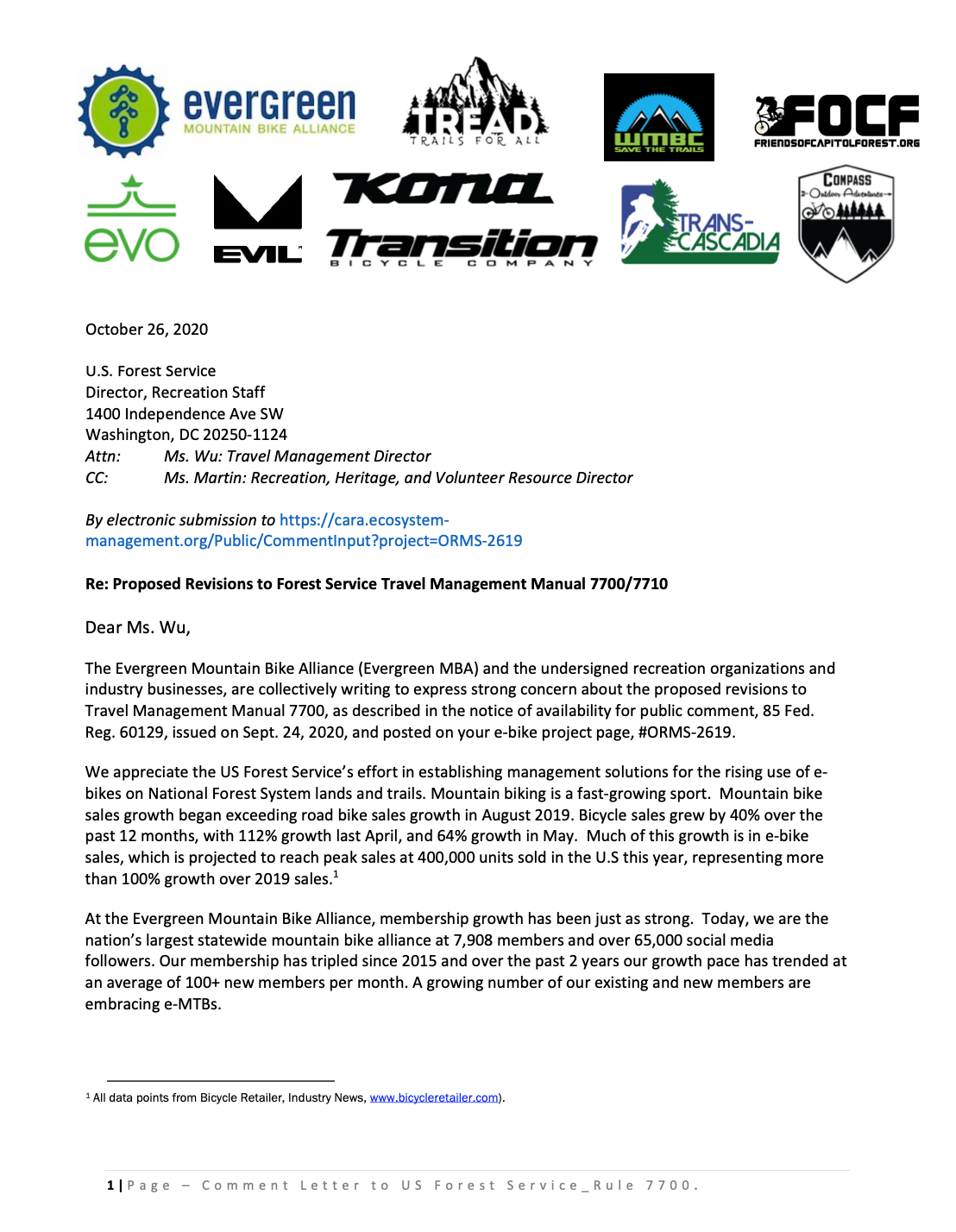Where can you legally ride your eMTB?
If you’re an eMTB user, "Where can I legally ride?" is probably your main question. Evergreen works hard to ensure the best experience for MTB and eMTB riders alike. Check our Trail Guide for a list of fun (and legal) trails (from Seattle to Wenatchee) for eMTBers to explore. Evergreen does not regulate trail use for eMTBs, nor designate trails as open or closed to use. Land managers have full authority to regulate trails for eMTB use, so please remember: Always check land manager regulations before riding a new trail!
In addition to the trails listed below, all motorized trails in Washington are also open to eMTBs.
Click on the pins for more info
We do our best to keep this map updated. Please contact us to suggest an edit, addition, or removal of a trail.
By default, all non-motorized single-track trails are closed to eMTBs, unless signed open and permitted by the land manager. EMTBs are allowed on all motorized recreational trails, which encompass hundreds of miles across the state, including epic single track in many of our National Forests.
Do the right thing: If there is no signage designating a non-motorized trail as open to eMTB– Please Stay Off!
In Summary, Washington e-Bike Law...
1. Establishes a regulatory framework for e-bikes and their use.
2. Classifies e-bikes as bicycles, as long as its power output is no more than 750 watts, it has a saddle, includes fully operative pedals, and meets the criteria of the following classes:
- Class 1: E-assist only while pedaling, with a maximum speed of 20 mph.
- Class 2: Can be propelled solely by the motor, with a maximum speed of 20 mph.
- Class 3: E-assist only while pedaling, with a maximum speed of 28 mph, and has a speedometer.
3. Gives land managers specific authority to regulate use of e-bikes on their properties.
4. Requires prominent labeling for all e-bikes containing the Classification Number, Top Assisted Speed, and Motor Wattage.
5. Enables Class 1 and 2 e-Bike access to roads, bike lanes and non-motorized paved and improved surface recreational trails, unless specifically restricted or signed closed by the local jurisdiction.
6. Restricts eMTB access to single track natural surface trails– unless the land manager designates and signs the trail as “open to eMTBs.”
Washington State E-Bike Legislation Passed In 2018
Evergreen worked with industry stakeholders to develop a regulatory framework for e-Bikes and e-Mountain Bikes (eMTB). The 2018 Legislation was primarily focused on allowing e-bike access on paved non-motorized trails for urban commuting and recreational purposes.
Our focus in this initial legislation was narrow– we wanted to ensure that:
- The new law established a sensible regulatory framework that defined e-bikes as non-motorized bicycles according to three unique e-Bike classes.
- Enabled land managers to introduce eMTB access on non-motorized trails in locations where the new technology may be appropriate.
- e-Bike management objectives for paved or otherwise improved surface non-motorized trails were separated from eMTB management objectives for natural surface single track trails.
- The management baseline remained “closed to eMTBs, unless signed open,” to allow strategic introduction where appropriate, and avoid trail conflict.
- Limit single track trail access to Class 1 eMTBs only (human-powered/pedal assist up to 20Mph).
We are satisfied with the outcome of this initial legislation as it defines e-Bikes as bikes, gives land managers specific authority to implement e-bike policies, and addresses a critical need for urban bike commuters. This means Evergreen can now work with Land Managers to advocate for eMTB access in places where we believe it makes sense, and where it does not threaten trail funding eligibility, existing uses, or a quality trail experience for others.
Next Steps for Evergreen
This initial legislation, is a great first step. Giving land managers specific authority to implement e-bike policies, allows us to work more collaboratively with other user groups and help to guide the discussion towards more broad acceptance, where appropriate. Evergreen will continue to work on future legislation specific to single-track trails and the mountain bike community.
We’re actively working to address the fast-growing eMTB technology by:
- Surveying our partner communities. Evergreen facilitated land manager discussion panels at trail conferences and events to discuss eMTB impacts and considerations on multi-use trails. We deeply care about eMTB impact to the non-biker experience on multi-use trails to ensure that mountain bike access to non-motorized trail is not questioned or threatened.
- Assessing risks to MTB trail funding. We’re working with our grant agencies to determine whether eMTB access to trails could potentially leave Evergreen ineligible for non-motorized trail grants. If the grant agencies don’t view eMTBs as “non-motorized,” Evergreen’s future grant opportunities could be greatly limited, as bike trails open to eMTBs would no longer qualify for grants. We're carefully assessing any potential risk to that funding as it remains our biggest income source for trail building and maintenance.
- Assisting land managers with creative solutions. We expect several land management agencies to develop access policies for eMTBs over the next few years, and Evergreen remains a close advisor in these discussions.Several land managers are evaluating development of eMTB trails closer to urban areas, as well as innovative ways to make them a reality. King County Parks—recognizing the lack of motorized trails in their parks and trail networks—is exploring options for new eMTB specific trails in response to growing demand.
- Facilitating ongoing discussion. We are working to convene our State’s Recreation and Advocacy organizations in identifying access and policy options for Class 1 eMTBs. We will also continue to engage land managers in regional panel discussion on this topic to identify a sustainable way to advocate for, introduce, and manage the new technology on trails without jeopardizing the trail access we worked so hard to secure over the past 30 years.
How e-bike use is regulated is crucial to Evergreen for several reasons:
- To allay concerns by our partners in joint non-motorized recreation planning efforts;
- To prevent potential loss of current trail access if land managers choose to close trails to all “bikes” because e-bikes may not be deemed compatible with other non-motorized trail uses;
- To protect funding eligibility for future state, federal, and local "non-motorized" grants; and
- To ensure the ability for land managers to enforce the regulations.
So, How Can I Advocate For eMTBs?
If you're a eMTB user, you might be left wondering– "How can I help advocate for access?" As land managers weigh the choice of whether to allow eMTBs on their trails, it's helpful for them to hear from the public. Here's how to advocate:
- Research your trails. Learn who the land manager is of the trails you're inquiring about and take time to research the history of trail use there. Is there already a long-running precedent for bike use on the trails?
- Familiarize yourself with current rules. Educate yourself on existing trail restrictions. Are the trails multi-use? Mountain bike specific? Are they two-way trails or directional?
- Write your land manager. Make sure to make your note personal. Share a story of how you use your MTB or eMTB to access trails. Be concise and specific with your comments.
- Share your experience. Tell us where you'd like to see access open up for eMTBs. We're always interested in hearing from local riders and what their experience is out on the trail.
Letter from Evergreen submitted to the U.S. Forest Service on October 26th, 2020 as part of an open public comment period seeking input on revisions to USFS e-bike policy.

